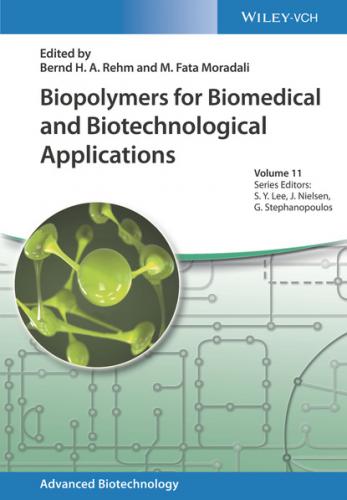Biopolymers for Biomedical and Biotechnological Applications. Группа авторов
Introduction 9.2 Synthetic and Natural Substrates 9.3 Applications of Natural and Synthetic Polypeptides 9.4 Applications of Polysaccharides 9.5 Conclusions and Future Outlook References
13 10 Biopolymers in Regenerative Medicine: Overview, Current Advances, and Future Trends 10.1 Introduction 10.2 Biopolymer Scaffold Assembly 10.3 Organ System Specific Biopolymer Scaffolds 10.4 Summary and Outlook References
14 Index
List of Tables
1 Chapter 1Table 1.1 Example classification and associated risks for two representative ...Table 1.2 Examples of common biopolymers.Table 1.3 Recommended TTC values from ISO 21726.Table 1.4 Standard device extraction ratios used for biocompatibility (per IS...Table 1.5 Standard body weight parameters.Table 1.6 Example of specific population doses for 1 g PLA screw.
2 Chapter 2Table 2.1 Examples of polysaccharides produced by bacteria and fungi displayi...Table 2.2 Bionanocomposites containing polysaccharides and their applications...Table 2.3 Polysaccharide‐producing microalgae and polysaccharide characteriza...Table 2.4 Microbial chitinous polysaccharide properties and applications.
3 Chapter 4Table 4.1 Homo‐PS structure (glucans).Table 4.2 Homo‐PS structure (fructans).Table 4.3 Monosaccharide ratio in hetero‐PS from PS database and recent studi...
4 Chapter 5Table 5.1 Medical uses of synthetic petroleum‐derived polymers.Table 5.2 Current industrial producers of CNF and CNC, including country of o...Table 5.3 Testing plan to characterize safety of CNMs.Table 5.4 Extensive overview of toxicological assessment of cellulose nanofib...Table 5.5 Plant‐derived CNF‐based materials for biomedical applications.
5 Chapter 6Table 6.1 Overview of techniques employed for the characterization of mucins ...
6 Chapter 8Table 8.1 DSC analysis of PHBH with various 3HHx fractions.Table 8.2 PHBH production byphaJ expression‐regulated strains.Table 8.3 Material properties of homo‐PHAs.Table 8.4 Comparison of material properties of biobased plastics and petroleu...Table 8.5 Material properties of P(3HB), P(LA‐co‐3HB), and PLA [94,96].
List of Illustrations
1 Chapter 1Figure 1.1 BioComposite Knotless SutureTak® anchor used in hip arthroscopy p...Figure 1.2 Thought process for using ISO 10993‐1 for biological evaluation o...Figure 1.3 Important aspects for setting up a chemical characterization stud...
2 Chapter 2Figure 2.1 Schematic representation of the fabrication of chemically and phy...Figure 2.2 Macroscopic aspect of injectable chitosan‐based hydrogels at (a) ...Figure 2.3 Top view of 3D printed hyaluronic acid (6% w/v) and Dex‐HEMA (10%...Figure 2.4 Microbial polysaccharide‐based nanocomposites with metal nanopart...Figure 2.5 Deacetylation reaction of chitin to chitosan.
3 Chapter 3Figure 3.1 Chemical structure of prominent microbial polysaccharides. Glc, gl...Figure 3.2 The mechanisms of the production of polysaccharides. Synthesis of ...Figure 3.3 Various mechanisms for determination of polymerization degree or t...
4 Chapter 4Figure 4.1 The Indian ink stain with non‐PS‐producible LAB (a, b) and with P...Figure 4.2 Outline of biosynthesis of hetero‐PS in a bacterial cell. Glucos...
5 Chapter 5Figure 5.1 Illustration of tissue engineering principle triad composed of th...Figure 5.2 Typical plasma drug concentration profiles: conventional dosage f...Figure 5.3 Commonly used biomaterials.Figure 5.4 Cellulose polymer chemical structure: (a) molecular structure of ...Figure 5.5 Hierarchical organization of cellulose polymer chain into microfi...Figure 5.6 Suitable positions for cellulose chemical modifications.Figure 5.7 Number of papers and patents released each year dealing with CNFs...Figure 5.8 From wood trunk to cellulose nanomaterials, the cell wall layer i...Figure 5.9 General procedure to obtain cellulose nanocrystals.Figure 5.10 Main mechanical treatment device for production of CNF suspensio...Figure 5.11 General procedures to obtain cellulose nanofibrils.Figure 5.12 Illustration of cellulase mode of action. β‐Glycosidase (βG) rel...Figure 5.13 Schematic mechanisms of regioselective oxidation of primary hydr...Figure 5.14 Komagataeibacter xylinus (also known as Acetobacter xylinum) pro...Figure 5.15 Five topics for the characterization of CNMs and associated char...Figure 5.16 (a) Number of patents dealing with CNF materials. Descriptors: c...Figure 5.17 Shape conformability and moist environment for reduction of pain...Figure 5.18 Release study of indomethacin from CNF films produced by filtrat...Figure 5.19 SPECT/CT images of 99mTc‐labeled human serum albumin injected in...Figure 5.20 SEM pictures of calcium crosslinked TEMPO CNF aerogels exposed t...Figure 5.21 Overview of the fabrication of the cellulose‐derived nanofibrous...
6 Chapter 6Figure 6.1 Mucins in the human body. (a) Mucus covers all wet epithelia and ...Figure 6.2 Purification of mucins from animal sources. A typical process for...Figure 6.3 The complex molecular architecture of mucins is responsible for t...Figure 6.4 Biomedical applications of purified mucins. Mucin coatings or muc...
7 Chapter 7Figure 7.1 Synthesis techniques for fibrous proteins. (a) Electrospinning....Figure 7.2 Morphological structures of several fibrous proteins. (a) Electros...Figure 7.3 Amyloid–HA hybrid film for bone tissue engineering application....Figure 7.4 Self‐assembled silk nanofiber hydrogel for drug delivery applicat...Figure 7.5 Self‐assembling Aβ fibrillar platform for detecting biomolecules:...Figure 7.6 The conductivity of synthetic protein nanowires. (a) The nanowire...Figure 7.7 Light harvesting of protein nanowire‐based hybrid nanomaterials: ...Figure 7.8 Electrospun nanofibrous NF membranes for
